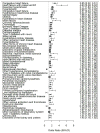Clinical Features Associated With Nascent Left Ventricular Diastolic Dysfunction in a Population Aged 40 to 55 Years
- PMID: 29627106
- PMCID: PMC5975107
- DOI: 10.1016/j.amjcard.2018.02.042
Clinical Features Associated With Nascent Left Ventricular Diastolic Dysfunction in a Population Aged 40 to 55 Years
Abstract
Diastolic dysfunction (DD), an abnormality in cardiac left ventricular (LV) chamber compliance, is associated with increased morbidity and mortality. Although DD has been extensively studied in older populations, co-morbidity patterns are less well characterized in middle-aged subjects. We screened 156,434 subjects with transthoracic echocardiogram reports available through Vanderbilt's electronic heath record and identified 6,612 subjects 40 to 55 years old with an LV ejection fraction ≥50% and diastolic function staging. We tested 452 incident and prevalent clinical diagnoses for associations with early-stage DD (n = 1,676) versus normal function. There were 44 co-morbid diagnoses associated with grade 1 DD including hypertension (odds ratio [OR] = 2.02, 95% confidence interval [CI] 1.78 to 2.28, p <5.3 × 10-29), type 2 diabetes (OR 1.96, 95% CI 1.68 to 2.29, p = 2.1 × 10-17), tachycardia (OR 1.38, 95% CI 0.53 to 2.19, p = 2.9 × 10-6), obesity (OR 1.76, 95% CI 1.51 to 2.06, p = 1.7 × 10-12), and clinical end points, including end-stage renal disease (OR 3.29, 95% CI 2.19 to 4.96, p = 1.2 × 10-8) and stroke (OR 1.5, 95% CI 1.12 to 2.02, p = 6.9 × 10-3). Among the 60 incident diagnoses associated with DD, heart failure with preserved ejection fraction (OR 4.63, 95% CI 3.39 to 6.32, p = 6.3 × 10-22) had the most significant association. Among subjects with normal diastolic function and blood pressure at baseline, a blood pressure measurement in the hypertensive range at the time of the second echocardiogram was associated with progression to stage 1 DD (p = 0.04). In conclusion, DD was common among subjects 40 to 55 years old and was associated with a heavy burden of co-morbid disease.
Copyright © 2018 Elsevier Inc. All rights reserved.
Figures




References
-
- Lam CSP, Lyass A, Kraigher-Krainer E, Massaro JM, Lee DS, Ho JE, Levy D, Redfield MM, Pieske BM, Benjamin EJ, Vasan RS. Cardiac dysfunction and noncardiac dysfunction as precursors of heart failure with reduced and preserved ejection fraction in the community. Circulation. 2011;124:24–30. - PMC - PubMed
Publication types
MeSH terms
Grants and funding
LinkOut - more resources
Full Text Sources
Other Literature Sources

